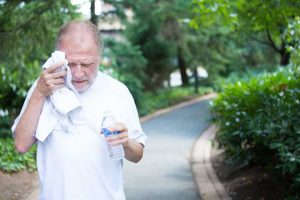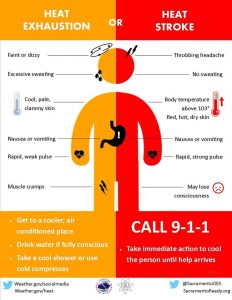Avoid Heatstroke This Summer
When temperatures rise and you start to feel the heat, take these steps to cool down–and to avoid the dangers of heatstroke.
Hot summer weather is perfect for swimming and barbecues. Too much of a good thing, though, requires caution: If you become too hot—easy to do during record-setting heat waves—you run the risk of risk of heatstroke. What is heatstroke? It’s defined as a condition in which you’re no longer able to cool down and no longer able to perspire. And as we read in the headlines during long stretches of stifling temperatures, heatstroke can become a serious and even fatal condition. “Who dies during heat waves? Older adults—whether in Paris or Chicago,” says Rosanne Leipzig, MD, PhD, of the Icahn School of Medicine at Mount Sinai in New York. “With aging, the ability to feel thirst and control sweating decrease, and severe dehydration can affect mentation and function, impacting the ability to call for help.”
What Puts You at Risk of Heatstroke?
The heat can be deadly for the very young. Their internal thermostat isn’t yet fully developed, putting them at risk of heatstroke. Heatstroke also is a serious risk in older people, because aging compromises the body’s ability to keep cool.
One of the ways the body naturally responds to rising temperatures is by dilating blood vessels in the skin. This draws heat from inside the body to the skin’s surface—perspiration. This process helps us cool you down, but as we get older, the ability to perspire can diminish, and blood vessels don’t dilate as efficiently—thus, heatstroke becomes more likely.

Heatstroke symptoms can develop rapidly depending on a person’s medical condition and the circumstances that individual is in.
Cause of Heatstroke
Certain chronic medical conditions also raise the risk of heatstroke, since they impair thermoregulation by the brain and nervous system. These conditions include cardiovascular, neurological, and psychiatric disorders, lung diseases (such as chronic obstructive pulmonary disease), obesity, and frailty. Certain medications that older adults are more likely to take (such as diuretics and other blood pressure drugs, sedatives, and tranquilizers) also may interfere with the body’s cooling mechanisms, increasing the risk of heatstroke.
Other seniors may have mobility difficulties that prevent them from getting out of a hot environment. And, with aging, the thirst reflex declines, increasing the likelihood of dehydration. The body mechanisms that counteracted dehydration when you were younger often become impaired as a part of normal aging. This leads to greater loss of fluids, and an increased likelihood of heatstroke and other heat-related illnesses. Even when dehydrated, many older people don’t feel thirsty and thus don’t compensate for their water volume loss.
You also may be susceptible to heat exhaustion and/or heatstroke if you overexert yourself in high temperatures, if you are exposed to extreme heat when you aren’t used to it (for example, if you vacation in a hot climate), or if you are obese.

Do you know the difference between heat exhaustion and heatstroke? Weather.gov supplies this infographic to differentiate.
Signs That Could Signal Heat Exhaustion or Heatstroke
Recognizing when the heat is starting to get to you is critical, because there are easy steps you can take to avoid medical emergencies. Keep in mind that a young child may not be able to tell you when he or she is too hot, while a senior may not even realize it, since he’s less sensitive to changes in their body temperature.
Early signs of heat exhaustion can include profuse sweating, weakness, nausea, vomiting, headaches, and muscle cramps. If someone has signs of heat exhaustion, it’s vital to move him or her to a cooler environment and take steps to hydrate (tepid water is best).
More life-threatening signs are those that progress to heatstroke. Signs of heatstroke include:
- A high temperature (above 104° F or 40° C)
- Flushed skin that feels hot to the touch
- Lack of perspiration (but keep in mind that if heatstroke occurs due to overexertion, the skin may be a little moist)
- Rapid heart rate and breathing
- Headache
- Nausea and vomiting
- No (or little) urination
- Confusion
- Slurred speech
- Seizures
- Coma
SOURCES & RESOURCES
For related reading, please visit these posts:
- Dehydration Headache: Know the Causes, Signs, and Treatments
- Sunburn: How Bad Is It for Your Health?
- Natural Cures for Nausea and Dehydration
- The Dangers of Dehydration: Swollen Eyes and a Shrunken Brain
Act Fast Against Heatstroke
Heatstroke symptoms can develop rapidly depending on a person’s medical condition and the circumstances surrounding individual (such as going without fluids for an extended time, being in an overheated room without ventilation, or long stretches in direct sun).
Heatstroke can cause irreversible organ damage if not treated quickly, so if someone has signs of heatstroke, treat it as a medical emergency—call 911 and take steps to cool the person. If he or she is in an overheated room or building, remove him from that location or lower the temperature in that space. Applying towels soaked in cool water to the person’s skin, or spritzing him with cool water and blowing cool air at him with a fan will help to lower his temperature.
If you are outside, spray the person with a garden hose, if that is the most convenient source of cool water. Get the person to drink as much as possible—cool water is usually the best fluid to consume, but certain sports drinks, such as Gatorade, are helpful because they replace sodium and minerals lost in perspiration. Avoid alcohol and sugary drinks (such as soda) because they can cause the body to lose more fluids. Also avoid iced fluids if possible, since these may cause stomach cramps.
10 TIPS FOR AVOIDING HEATSTROKE
- AC AND SHADE: Keep your home cool with air conditioning if affordable, and by lowering window shades during the day.
- MADE IN THE SHADE: Try to stay out of the sun between 10 a.m. and 4 p.m.
- CONSIDER CLOTHING: Wear lightweight, light-colored, loose-fitting clothes when you’re outside.
- OUTDOOR SMARTS: If you enjoy exercising outside, do it first thing in the morning or in the evening (assuming the temperature has cooled down sufficiently).
- HYDRATE: Drink fluids throughout the day. If you’re outdoors or engaging in exercise in the heat, drink between 16 and 32 ounces of cool fluids per hour, unless otherwise directed by your doctor.
- OUT AND ABOUT: On days of high heat, go to public places that have air conditioning—malls, senior centers, libraries, and movie theaters, for example.
- BUDDY SYSTEM: Spend time with others so that someone can take action if you start to experience heat-related symptoms. This is especially true when exercising or spending extended time outdoors.
- CAR CAUTION: Never leave a young child or older adult in a parked car on a hot, sunny day—the temperature inside can increase rapidly.
- MEDS AND RISK: Find out whether any medications you or a loved one take raise the risk for heat-related illness and heatstroke.
- VACATION TIME TIPS: If you’re vacationing in a hot climate, spend a day or two acclimating before engaging in sightseeing.


 Personal Beliefs About Drugs Influence Brain Activity
Personal Beliefs About Drugs Influence Brain Activity  MGH Study: Hot Yoga May Help Ease Depression Symptoms, but Be Mindful of Health Concerns
MGH Study: Hot Yoga May Help Ease Depression Symptoms, but Be Mindful of Health Concerns  Black-Eyed Peas, Please!
Black-Eyed Peas, Please! 
One of multiple tips we offer to avoid heatstroke: If you enjoy exercising outside, do it first thing in the morning or in the evening (assuming the temperature has cooled down sufficiently).
© Photojogtom | Dreamstime.com